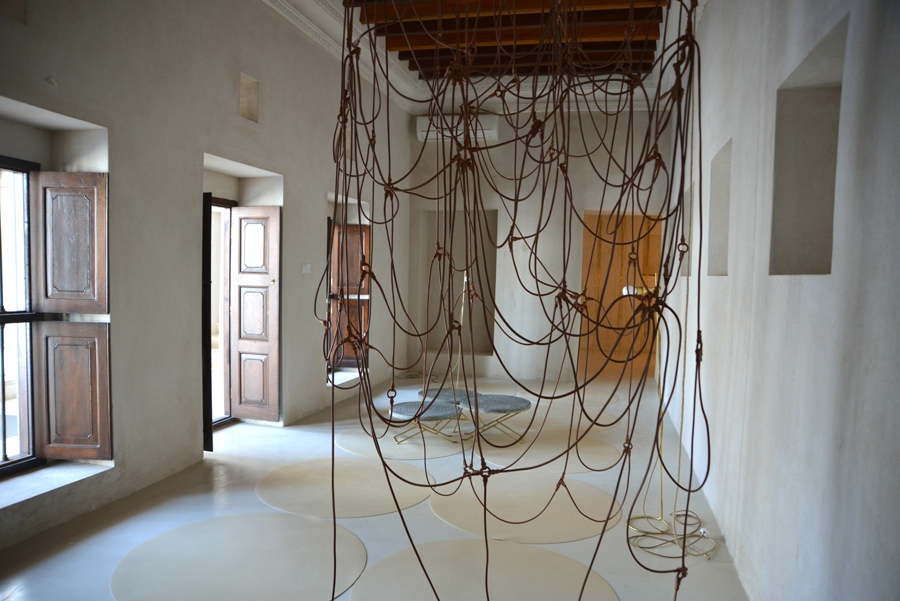If it is not a gesamtkunstwerk, then it is at least an artwork applying the ‘overall’ principle three-dimensionally: the floor and the ceiling are host to metal lamps with spindly legs and long cables, round tables made of concrete with brass legs, black-and-beige circular linoleum mats, wooden screens with biomorphic holes in them, suspended webs made of brass, handwoven nets and halterlike details made of leather, as well as long ropes connecting the many wooden beams in the ceiling. The old plastered walls are in use too, but by implication rather than directly.
Leonor Antunes’s work The Unpredictability of Possible Future Uses (2015), made specially for this year’s Sharjah Biennial, is everywhere in the corridor and the five rooms it occupies, although minimally so. There is no abundance of objects; instead a smallish number of things furnish, or rather populate, the former hospital in Old Sharjah, right by the corniche, which in recent years has been cleared of dhows, the old wooden cargo boats that for centuries have transported goods across the Persian Gulf. Antunes’s objects are carefully crafted, several of the same kind creating a sense of repetition throughout the spaces, which were supremely quiet when I went there two days after the biennial opening.
The possible future uses of both the exhibition space and the different components are indeed unpredictable, from the point of view of their previous functions in relation to today, as well as their uses in a future to come. The old medical facility, refurbished and now housing this year’s biennial, as part of an endeavour that plays into a number of more or less problematic processes, such as gentrification and political whitewashing, has taken on a new function. Antunes’s tables and mats hark back to mudbrick tombs in Mellieha (in the northwest part of Malta) dating from 150 BC and palm-leaf mats for eating on the ground used by local nomads. Like indigenous Amazonian techniques for hammocks, the suspended nets lack knots, making them more stretchable than other nets.
The appropriation of local materials and techniques by Antunes is of course unpredictable in relation to their original function and location. Equally so with the shapes and functions borrowed from the designer and architect Greta Magnusson-Grossman (1906-99). Born and educated in Sweden, she set up a successful design studio in Stockholm during the 1930s before emigrating to Los Angeles, where she continued to make furniture and started designing houses. In addition to the 20-odd single-family houses, most of which were made for professional women and couples without children and located on ‘difficult plots’, she created entire interiors for Southern California’s local jetsetters, among others Greta Garbo and Paulette Goddard.
It is Grossman’s tactile and soft-edged functionalism that recurs in Antunes’s work, particularly in her use of Grossman’s Grasshopper lamp (1948), which in Antunes’s hands is the only source of light in the dark rooms of the former hospital in Sharjah. But it is also there in the mats and the low tables with folded metal legs, and the inclination to treat the interior as a whole. Not only was Grossman a rare case of a woman who saw her ideas being realised both in design and architecture, but she also took particular care with the whole experience of the building. Similarly, Antunes’s ‘overall’ is restrained – not exactly overall but nevertheless no horror vacui. A sort of modest overall with personality. As one of many commissions for Sharjah Biennial 12, this particular artwork points both backwards and forwards in time, at the unpredictability of uses for an object in the past and towards those undefined uses still to come. Yet it pertains to something predictable: the remaining importance of biennials and other institutions to support new work. Together with commissions by Michael Joo, Haegue Yang, Iman Issa, Ayreen Anastas & Rene Gabri and Basel Abbas & Ruanne Abou-Rahme, Antunes’s The Unpredictability of Possible Future Uses is worth the trip to the Gulf.
Sharjah Biennial 12: The past, the present, the possible, 5 March – 5 June 2015
This article was first published in the May 2015 issue.
